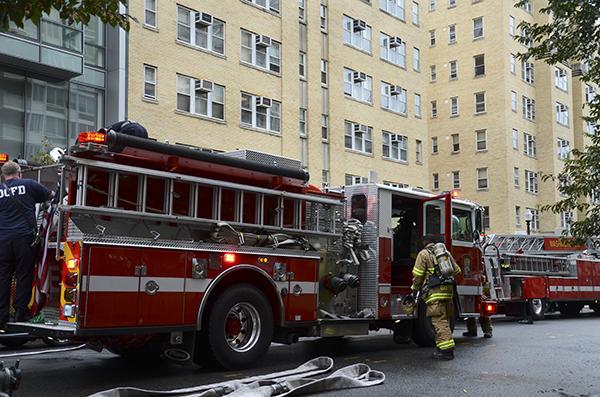Half of all reported fires in GW residence halls have originated in kitchens over the last six years, according to public records from D.C. Fire and EMS.
Thirteen out of the 26 fire incidents on campus since 2010 started in the kitchen in a residence hall room, according to the documents. In 10 of the incidents, the occupant had left the kitchen while an appliance was on, and eight times, a stove was left unattended, according to the documents.
The Hatchet obtained all 26 fire reports through a Freedom of Information Act request, illustrating details about the fires that officials have not released before. Experts say the fires should serve as a wake-up call for officials: Students need training about safely using stovetops to prevent potentially larger fires in the future.
Jack Dowling, the former director of safety and security for Philadelphia University and Bucknell University, said university administrators should consider implementing a mandatory fire safety programs for students who live on campus.
“It is always good to have awareness education programs when you are involved with fire safety risks,” Dowling said. “Educational awareness is an important part of preventive measures.”
One male student sustained minor burns on his arm and wrist from a grease fire in 1959 E Street in 2011, according to the documents. Another report shows that a firefighter was injured while responding to a stove fire in South Hall in 2014.

In 2012, firefighters responded to a fire in a kitchen trash can in The Dakota and found “discarded smoking materials from a water pipe” after putting out the fire, the documents read.
The most recent fire on campus was a fire on the fifth floor of Fulbright Hall last month, which officials said started after a student threw a cigarette in a trash can.
Most of the fire reports either did not list the property damage from the fire or stated that there were no damages. One kitchen fire led to $150 in damages to property and contents in the building. A dryer fire in The Dakota in 2012 also resulted in $350,000 in damages to the equipment and contents inside the laundry machines, according to the documents.
Out of the three fires recorded in the documents in 2015, two of them were cooking-related. Munson Hall was evacuated in September after reports of burnt food in a room on the eighth floor. The official fire report stated that the incident was caused by food burning inside an oven.
Last June, firefighters responded to a small kitchen fire on a the 10th floor of City Hall, but the fire was already extinguished when firefighters arrived on the scene, according to the official report. A resident leaving the stove unattended was the cause of the fire, according to the report.
Burning food in conventional overs caused two of the 12 cooking fires, according to the documents. A small fire was confined to a conventional oven at Shenkman Hall in 2011, but was put out before firefighters arrived at the scene.
One fire in City Hall in 2013 was caused by friction between a broken kitchen appliance and flammable liquid, according to the report.
Senior Associate Vice President for Safety and Security Darrell Darnell said he hasn’t noticed an increase in cooking fires in recent years, and said fire drills are conducted at every residence hall twice a year.
“The fire safety equipment is standardized across all buildings, no matter the age of the building, and are built or installed to code, then tested on an annual basis,” Darnell said. “All of our multilevel residence halls are built with stone or bricks with plaster walls and thus are more fire resistant than a typical family residence built from wood and drywall.”
Darnell said students “receive a variety of information about safety and security systems and processes during floor meetings and a range of other education sessions” like the Safety and Security Expo held in University Yard each fall.
Currently, GW does not hold any mandatory fire prevention programs for students living on campus. All incoming freshmen who attend Colonial Inauguration are encouraged to attend a session about residence hall safety and review fire safety information.
Darnell added that all residence halls have fire evacuation plans pasted inside every door. Each residence hall room with a kitchen has a fire extinguisher.
About 86 percent of structural fires on college campuses are cooking related, according to a 2015 study from the National Fire Protection Association.
“GW is doing pretty well based on our statistics, but there is always room for improvement,” Judy Comoletti, the division manager for public education at NFPA, said. “Cooking fires are not only the leading cause in dorms, but the leading cause in general.”
When a fire alarm is pulled in a residence hall, University Police Department officers respond to the source to verify the severity of the alarm. If an active fire is verified, UPD officers would report the incident to the Metropolitan Police Department and D.C. Fire and EMS, who become the lead agencies in the emergency situation. UPD officers and resident advisers are also involved in making sure residents leave the building.

Kevin McSweeney, the fire marshal at University of Delaware, said that starting next semester, his university is offering an optional course on cooking safety. The course is not for credit and is free for students.
“The course is focused on how to set the microwave properly and cooking safety,” McSweeney said. “We are offering it because students have requested it and they want better results in their cooking skills.”
He said the college has installed safety devices to regulate stove temperatures including a “smart burner” to help prevent cooking fires. He said the university also sells microwave safety sensors that turn off the microwave when food inside is being overcooked.
“A leading cause to microwave incidents is that people either overheat their food by setting the microwave on high or letting food heat much longer than needed,” McSweeney said.







